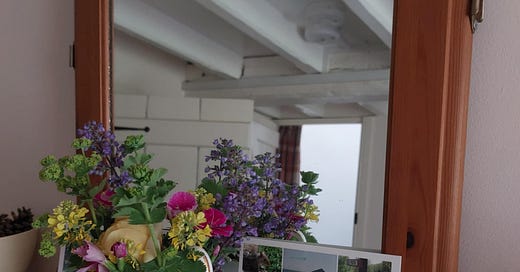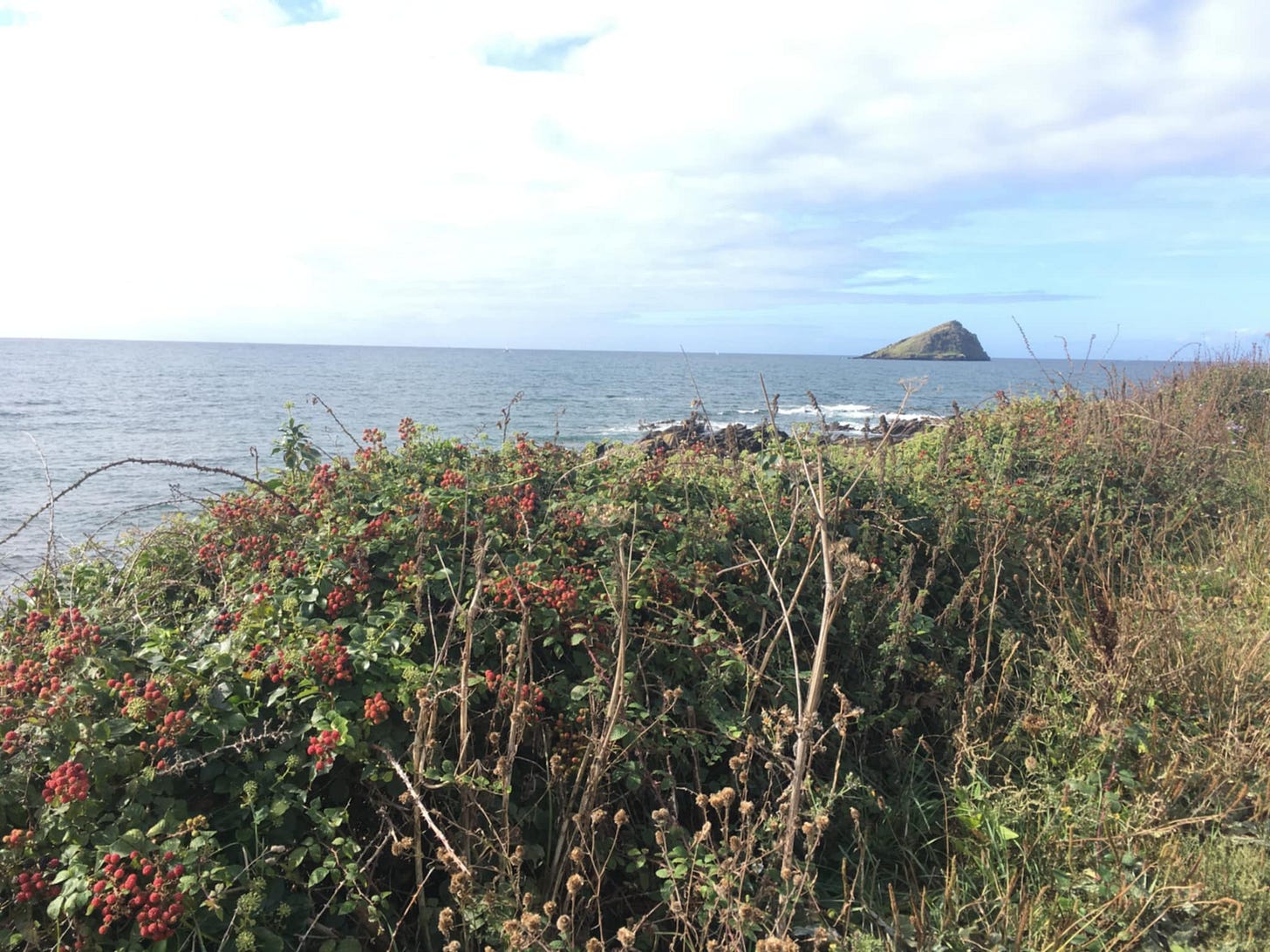My parents have just arrived home from a week’s holiday in one of our favourite places. Their postcard, propped up on the mantlepiece fills me with a sense of nostalgia. Nestled in the valley that leads down to Wembury Bay, a famously rich marine habitat and beautiful coastal location, is a holiday park made up of wooden cabins tucked quietly amongst the trees and hydrangeas. Churchwood Valley has always been a unique and special place, prized by those who know it, for its tranquility and peace and wildlife; the site is also the winner of a number of environmental awards. [This is not an Ad] Churchwood Valley
As I read Mums cursive handwriting on the back of the postcard whilst I drank my tea a few days ago, I was reminded of the visits I have made to Wembury over my lifetime; first with my parents and brother, later as a teenager, then again, after a long gap, in late 2019 with the man who during that holiday became my fiancé, and I have since married. After that last visit, I was inspired to write a blog laced with nostalgia and memories…
The following was originally written and published on my Wordpress blog May 23, 2020
“ We have reached late May, and just over a week after a late season frost, the sun beats down with force. There’s no rain forecast for at least two weeks. A fine film of dust is settling in the leaves of the oaks, the first layering which will dull the spring growth to its darker summer green. Great tit chicks in the tree hole are soon to fledge. From above, the knitted canopy now plunges the woodland floor into shadow; this is what the early spring flora were racing against, the dying of the light. Clouds of pook flies sparkle in sunbeams. Summer is not yet mature, but spring grows old. Breeze winnows the cow parsley in the lane, thinning the petals from the airy heads.
What image do you see when you close your eyes? When I dream, the land is forever later on in the year on a soft slide from summer into autumn. (The land in turn dreams in trees.) I though, am above the land, detached on a voice of breeze. And the Great Mew Stone rises before me from the bountiful seas. Flint-glint of gannet, salt-stiffened wings, headlong angled, a wind-puppet with absent strings.
I’ve been thinking about this place a lot recently, it seems to haunt me. Wembury bay, where two headlands dip to allow a streams chilly waters to giggle out over the sand to its mother sea. I am not a natural dweller of the coast, my natural habitat is that of the woodland edge and field hedge, the wild garden and downland combes. I visit the beaches now and then, as I wrote in one of my poems; “as though to check the sea’s still there.” I cannot swim and am wary of water. Plants and creatures of the maritime seem remote and unfamiliar in both character and name. There is however one section of coastline that would, if it asked, beguile me into forsaking my grassy knolls and ant mounds, beech hangers and totty land. I’d leave Sussex for a life bewitched by a view of the Mew Stone.
The inspiration of a place can be subtle and uncanny. For years, if you asked me to doodle a drawing of an island, all would have the same distinctive slant, the same rocky footings, a shifting sea-sky that was hued by my mood. It was only last year when I reconnected with a childhood holiday location that the clues fell into place. I stood in the valley mouth, cold stream water eddying over my feet, and gazed at the island that lay off the bay and felt a link click. Wembury, nr Plymouth in South Devon. I remembered towering foxgloves, but this was the last week of August so the June blooms had long since faded, and I’m taller now. The smell of salt on sun ripened blackberries, the robins’ twittering in the valley shade. Gull-white against clouded sea. And a triangular island, rocky footed with a distinctive slant…all just where I left it two decades before.
I don’t remember exactly what age I was when I first stayed at Churchwood Valley, maybe 6 or 7. I recall images, like mental postcards, rather than specific holidays. It must have been May break, or early July when school had finished. Each day we’d breakfast; I’d prefer to feed my crusts to the birds, insisted my dad put out a few peanuts purchased at the park shop for the squirrel. Bickered with my elder brother over the jam, or who-kicked-who under the small table. We’d leave the chalet in dappled sunshine and dubious shorts. Foxgloves grew tall and spire-like on the banks; bee-throated and just faintly unnerving. It seemed like we never reached the end of the lane before the drip drip patter of rain beat us too it. Did we really have cream tea every afternoon? I have no memory of spending time on the beach and rock pools back then, maybe the coverlet of tide was always pulled up to the shore. Walks on the headlands are recalled only in the impossible solid tremor of a hovering falcon, fixed hunger-eyed above the rough. I smell gorse, hear their seed pods pop to a cracked twist, but that is a memory that belongs to another place, I’m not sure there’s any gorse on Wembury’s headlands. Hydrangeas in the valley, crooked pines and sea campion, yes, and brambles.
I returned to Churchwood Valley and Wembury bay, the summer I left school. By then I had caught the wildlife photography bug, and viewed much of the holiday through a camera lens. There still was squirrels on the patio, robins at breakfast. A pair of bank voles climbed the brambles below the windowsill of my parents room.
This time when I returned I delved deeper into the place, revelling in each reveal. I needed to know it, to form a new and equally valid connection between the spirit of place and my own self. Forge new associations and new memories fit for a different phase of my life. The Wembury I discovered last summer, (one of rock pools and starfish, pipe fish, winkles, hidden crabs, silky leather touch of seaweed, walks after breakfast and so much more), may have shared the same soul as the one I knew in childhood, but we met as strangers and I delighted in that new bond.
I keep a postcard on my desk, propped against the lamp beside my books, tattered maps, and jars of findings. And sometimes when oaks and chalk meadows and flint-faced cottages become dulled by familiarity, it’s good to gaze on the image and know the view of the Mew Stone will be waiting when I return. Maybe even now, the falcon hangs on this stiff breeze that has picked up, hunger-eyed above the rough on the headland.





